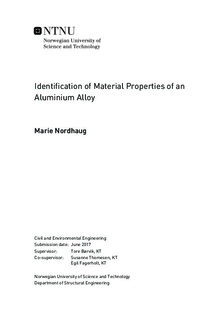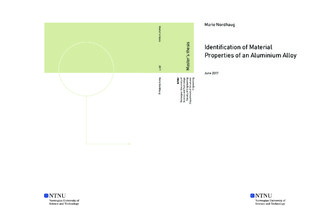| dc.contributor.advisor | Børvik, Tore | |
| dc.contributor.advisor | Thomesen, Susanne | |
| dc.contributor.advisor | Fagerholt, Egil | |
| dc.contributor.author | Nordhaug, Marie | |
| dc.date.accessioned | 2019-09-11T08:34:40Z | |
| dc.date.created | 2017-06-11 | |
| dc.date.issued | 2017 | |
| dc.identifier | ntnudaim:17586 | |
| dc.identifier.uri | http://hdl.handle.net/11250/2614886 | |
| dc.description.abstract | Uniaxial tension tests of small versus large round specimens and small versus large flat specimens from a 3XXX series aluminium alloy were carried out to identify the mechanical properties of the material. Different measurement techniques such as laser micrometer, edge tracing and Digital Image Correlation (DIC) were applied in the tests. In addition, extensometers were used to validate the results from the edge-trace and DIC approaches. The results from the tension tests were processed and the true stress-strain curves were obtained. For the round specimens, the data were measured all the way to fracture while for the flat specimens the measured data were only evaluated until diffuse necking. The results showed good agreement within each specimen geometry and measurement technique. A deviation between the small round specimen and the three other specimen geometries was observed in the comparison of the round and flat specimens.
Based on the experimental results the material constants in the modified Johnson-Cook (MJC) constitutive relation were calibrated. The measured data from the flat tension tests had to be extrapolated from diffuse necking. The method of extrapolation was discussed and, depending on the hardening laws, the extrapolation gave different material behaviour at large plastic strains. This showed that the method of extrapolation is only an approximation that could lead to an incorrect material behaviour in complex nonlinear structural problems.
Fracture was not evaluated in this thesis, hence ABAQUS/Standard was used in the numerical work. Simulations of the tension tests based on the direct calibration were performed and the results corresponded with the experimental results, hence the direct calibration predicted the material behaviour well in this case. The material parameters in the MJC constitutive relation were optimized using inverse modelling in LS-OPT. Compared with the experimental results, the optimization gave a very good fit for the flat specimens, while it resulted in a lower stress level at large plastic strains for the round specimens.
Finally, a numerical case study was performed to investigate that the material properties obtained from the round and flat tension tests gave the same result in a nonlinear finite element simulation. The study showed that the material data from the round and flat specimens resulted in approximately the same material behaviour in a complex nonlinear problem with large plastic strains in this case. This demonstrated that the round and flat tensile specimens were both valid to identify mechanical properties of materials. | en |
| dc.language | eng | |
| dc.publisher | NTNU | |
| dc.subject | Bygg- og miljøteknikk, Beregningsmekanikk | en |
| dc.title | Identification of Material Properties of an Aluminium Alloy | en |
| dc.type | Master thesis | en |
| dc.source.pagenumber | 89 | |
| dc.contributor.department | Norges teknisk-naturvitenskapelige universitet, Fakultet for ingeniørvitenskap,Institutt for konstruksjonsteknikk | nb_NO |
| dc.date.embargoenddate | 2020-06-11 | |

